Blog
How Do Tooth Coloured Braces Compare To Other Treatments?
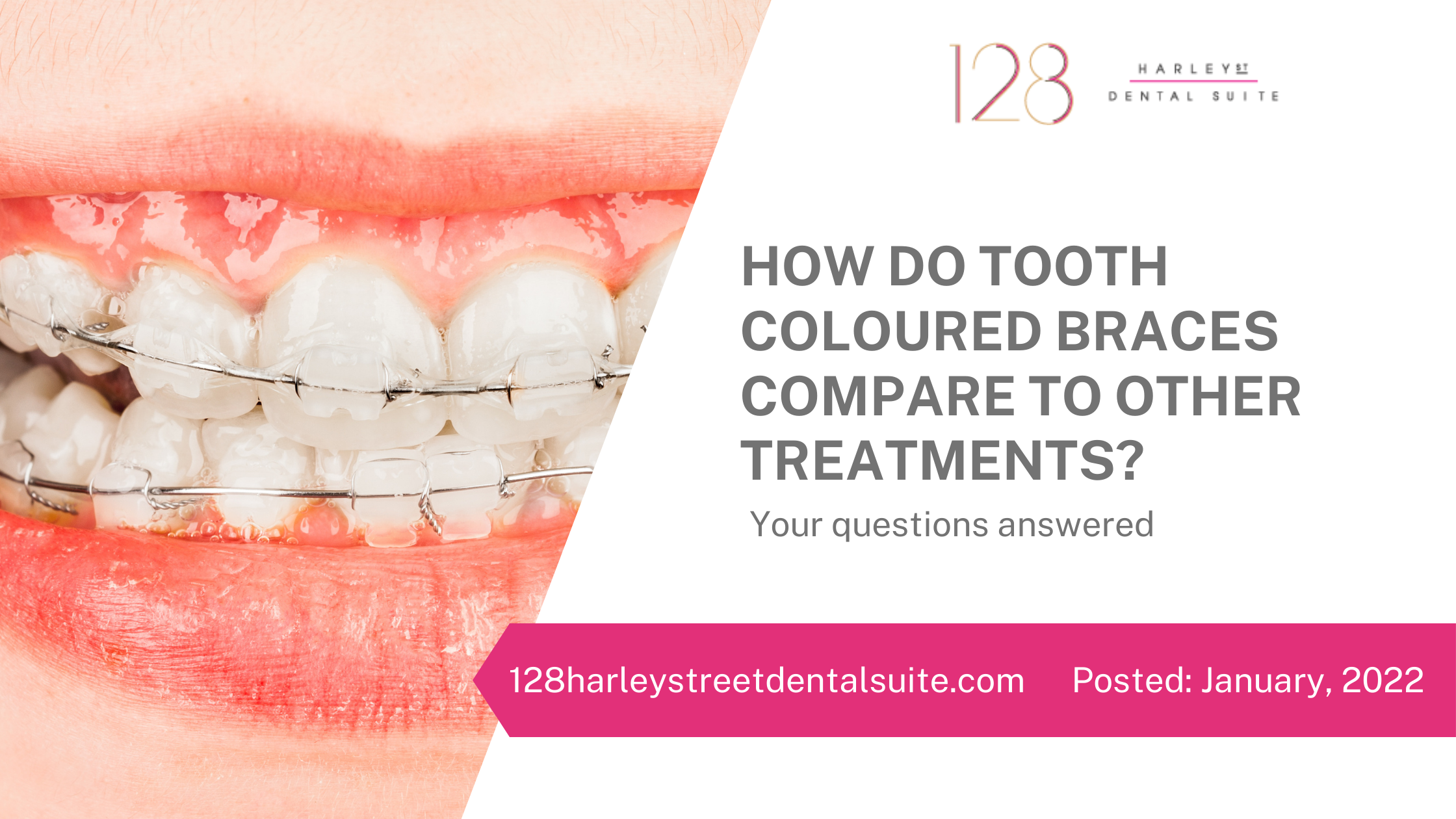
If your dentist has told you that you need braces, and you’re not happy with the idea of wearing those conspicuous and uncomfortable metal braces, no need to worry; there are other aesthetically more pleasing and convenient treatment options available for you to choose from. For example, you can get tooth-coloured ceramic braces for your treatment that blend with your teeth and are virtually invisible when worn. So, are you Interested in learning more about ceramic braces? This article explains everything you need to know about tooth-coloured fixed braces.
How Are Ceramic Braces Better Than Metal Braces?
Many prospective orthodontic patients would simply refuse treatment a few years ago because they did not want to wear the unaesthetic metal braces. However, things have changed now. Today, tooth-coloured ceramic braces are available that precisely match the colour and shade of your teeth and hence, they do not make you self-conscious about wearing braces. This is also the most significant advantage of ceramic braces over traditional metal braces.
Why Is It Necessary To Straighten Your Teeth Alignment?
Our teeth perform several functions. First, they allow us to chew food properly to be broken down into smaller pieces and digested correctly. Secondly, our teeth enable us to pronounce words clearly. Finally, perfectly aligned teeth significantly improve one’s smile and facial aesthetics. If one has misaligned teeth, not only their ability to eat and speak normally will be affected, but they will also have a flawed smile. Therefore, getting your teeth straightened is necessary for cosmetic and functional reasons.
What Are The Treatments Available For Straightening Teeth?
Modern dentistry offers several orthodontic treatment options and cosmetic treatments to fix tooth misalignment:
- Traditional metal braces
- Ceramic braces
- Lingual braces
Among the fixed orthodontic appliances, these are some of the commonly used. Each brace system consists of brackets that are bonded to the teeth. Your dentist will use elastic bands to attach orthodontic wires to the brackets. Apart from fixed appliances, removable orthodontic systems like clear aligners are also available for straightening teeth.
What Is The Difference Between Clear Braces And Clear Aligners?
Clear braces is a term used for fixed brace systems that are either made from a transparent or tooth-coloured ceramic material. Regardless of the material, clear braces remain bonded to the teeth and move them through the tension in the orthodontic wires attached to them with elastic bands. On the other hand, clear aligners are removable trays worn over the teeth, just like mouthguards. Clear aligners are designed to sit over the teeth and gradually move them in the desired direction.
What Are Some Tips For Choosing The Colour Of Your Braces?
When we talk about the colour braces, it usually refers to the colour of the elastic ties. Did you know that you could make your teeth appear whiter by selecting the right colour of elastic bands? People with yellow teeth should choose dark colours such as royal/navy blue or purple. You may also choose clear or silver-coloured elastic ties. Choosing light colours may cause them to stain quickly, making your teeth look stained.
What Braces Colour Should One Avoid?
You should avoid getting elastic band colours such as white, yellow or golden. All these colours will make your teeth look yellower and stained. Instead, the idea is to wear dark-coloured bands that contrast with your teeth and make them look whiter. Your dentist or orthodontist can help you select a colour for your elastic bands that makes your teeth look whiter.
Which Is Better, Ceramic Braces Or Clear Aligners?
Both these orthodontic treatment options have their pros and cons. Fixed appliances like ceramic braces can treat complex orthodontic problems involving the bite. However, they are not suitable for people who have a habit of grinding their teeth, as the ceramic brackets can cause wear of the opposing teeth. On the other hand, clear aligners should be your choice if you prefer comfort and convenience.
What Colour Braces Should I Get If I Have Yellow Teeth?
The colour of your elastic bands can significantly impact the apparent colour of your teeth. Therefore, you should select an elastic band colour that makes your teeth look whiter. For example, dentists recommend wearing shades of silver or clear bands for yellow teeth. Alternatively, you may wear dark-coloured elastic bands like dark blue or purple. White-coloured bands should be avoided as they get stained easily and make your teeth appear darker. Similarly, black ties shouldn’t be worn as they have high contrast with your teeth.
What Is The Advantage Of Ceramic Braces?
Ceramic braces offer several advantages over other orthodontic treatment options;
- Inconspicuous – unlike traditional metal braces, ceramic braces are made from tooth-coloured ceramics. Therefore, they are virtually invisible, and they won’t affect your smile or appearance.
- Improved Self-confidence – since ceramic braces blend with your natural teeth, they will make you less self-conscious and improve your overall confidence.
- More Comfortable than Metal Braces – ceramic braces offer superior comfort and convenience over conventional metal braces.
- Better Option for Forgetful Patients – patients who often forget to wear their aligners for the prescribed duration can benefit from ceramic braces which remain fixed to their teeth.
If you’re considering orthodontic treatment for yourself or a family member, make sure you go to a qualified dental specialist. If you are looking for the best family dental practice in London, 128 Harley Street Dental is the best choice. Whether you need braces or clear aligners for your kids, or teeth whitening for yourself, we offer all dental services at affordable rates under one roof. So, book a new appointment today and let us experienced and skilled dentists do their magic! We look forwards to serving you.
How To Stop Grinding Teeth?
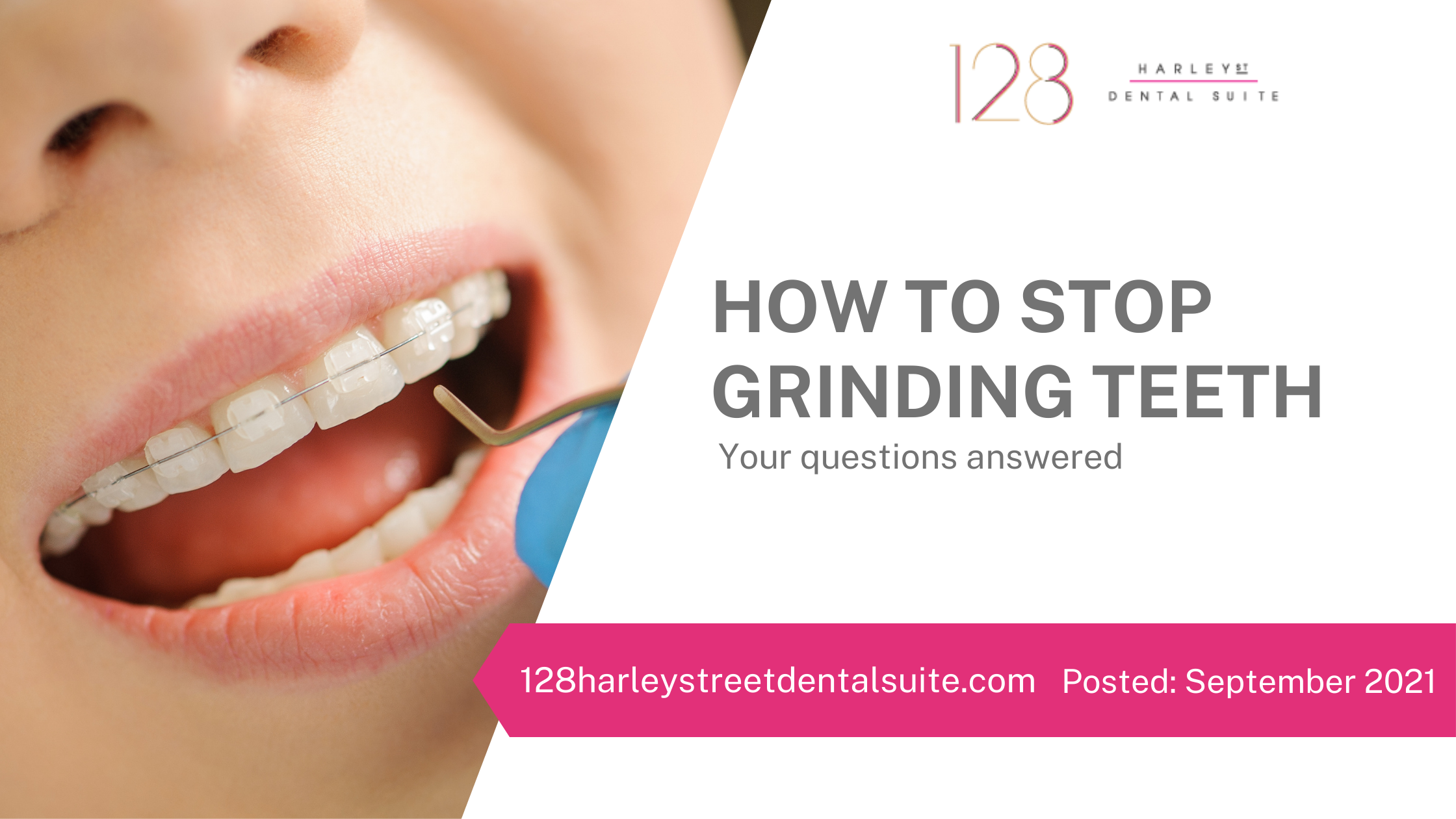
Do you feel soreness in your facial muscles and jaw joints when you wake up every morning? Do you think that your teeth have become sensitive and mobile? If the answer to the above is yes, you may be grinding your teeth excessively during the daytime, while sleeping, or both. But you don’t have to worry; you are not alone. According to the Bruxism Association, teeth grinding, also known as bruxism, affects 8-10% of the British population, most common among 25-44-year-olds. While the habit of grinding teeth can be detrimental to your teeth and oral health, the good news is that bruxism can be easily diagnosed and treated. This article explains everything you need to know about bruxism – diagnosis, causes, and treatment. So, read on to find out more.
How Is Teeth Grinding Diagnosed?
Bruxism in individuals is most commonly identified by dentists and orthodontists based on patient symptoms and findings of routine clinical checkups. For example, patients who have a habit of grinding their teeth often have sore jaws and facial muscles. Besides, dentists find signs of teeth grinding during routine clinical examinations, which typically include:
- Flattened tooth surfaces due to excessive wear
- Eroding of the enamel leading to tooth sensitivity
- Tightness or spasm of the facial and jaw muscles
- Difficult or painful mouth opening or closing
- History of frequent headaches
Perhaps, the most conclusive diagnostic method for bruxism, according to the Sleep Foundation, is polysomnography. This is a diagnostic test that is designed to determine your overnight sleep pattern. However, polysomnography is time-consuming and expensive. Therefore, it is not routinely performed, and clinical examinations are usually sufficient for diagnosing bruxism. Besides polysomnography, other home-based monitoring tests can also be performed, but they are less accurate.
How Is Bruxism Treated?
The treatment of bruxism involves eliminating the underlying cause. This is usually done in two phases. In the first phase, your dentist will give you appliances like nightguards to prevent further damage to your teeth. Meanwhile, they will diagnose the underlying issue and perform specific treatments to eliminate it.
What Are Some Treatments To Cure Bruxism?
As discussed earlier, orthodontists treat bruxism by treating the underlying cause. If bruxism occurs due to an imbalanced bite, dentists or orthodontists typically use appliances known as occlusal splints. According to the Bruxism Foundation, these appliances are the treatment of choice as they reduce the grinding noise and protect the underlying teeth from further damage. The occlusal splints reduce muscle activity associated with night-time bruxism.
However, these appliances are used for symptomatic treatment and do not address the underlying issue. To address teeth misalignment issues that cause grinding, dentists may perform orthodontic treatment to realign the teeth. If the misalignment stems from jaw misalignment, then orthognathic surgery may be needed. Another type of appliance, called the mandibular advancement device (MADs), can also treat bruxism and sleep apnoea. Sometimes, behavioural therapy is also required for patients who grind their teeth due to excessive stress or anxiety.
Why Do Some People Grind Their Teeth In Their Sleep?
In some instances, bruxism can also be related to sleep disorders like obstructive sleep apnoea. In this type of apnoea, patients have several “cycles” of teeth grinding, along with other symptoms like difficulty breathing and suddenly waking up from sleep. Another associated symptom, according to the National Health Service (NHS), is sleep paralysis – a transient situation in which one is unable to move or sleep while awake or sleeping,
Is There A Permanent Solution To Bruxism?
Your dentist will treat bruxism by diagnosing and removing the underlying cause. If the reason is tooth misalignment, then your dentist will treat it permanently with orthodontic treatment. More complex cases involving jaw misalignment are usually treated with orthognathic surgery. This type of surgery is performed to optimally realign the jaws to improve dental function and treat teeth grinding.
How To Stop Myself From Grinding My Teeth In My Sleep?
There are several ways to treat sleep bruxism. If you feel that you grind your teeth during sleep, you should visit your dentist without delay. They will perform a clinical examination and run tests to determine the underlying cause. Then, based on their fundings, they will prepare a treatment plan for you, sometimes in consultation with your doctor or behavioural therapists. Depending on the issue, they will fix it either through orthodontic treatment, splints, advancement devices, sleep hygiene improvement, or behavioural therapy.
Do I Really Need A Night Guard For Bruxism?
According to the American Sleep Foundation, night guards are appliances that are worn over the teeth. These appliances prevent the underlying teeth from excessive wear and pressure caused by tooth grinding. Typically, night guards are the first appliances to be given by dentists to bruxism patients to prevent further tooth damage and avoid complications like tooth sensitivity, jaw muscles and joint problems and tooth decay.
How To Stop My Jaw From Clenching?
Jaw clenching, like bruxism, can also have harmful effects on your oral health. The best way to prevent yourself from jaw clenching is to do jaw and facial muscle relaxation exercises, as advised by your dentist. You should also wear a night guard while sleeping to prevent your teeth from excessive wear and accidental fracture. In addition, your dentist may advise diet and lifestyle changes to decrease stress or anxiety.
Tooth grinding can have a severely damaging effect on your oral health and physical being. However, the good news is that bruxism can be treated with simple treatments. If you or a loved one suffers from the habit of teeth clenching or grinding, don’t ignore it; let us help them prevent their teeth and smile.
So, book an e-consultation appointment with us today and get a free estimate from us upon full completion. At 128 Harley Dental Suite, we are there to take care of all your dental needs.
Ceramic Braces – The Full Story
 If you have been holding back on your orthodontic treatment just because you don’t want to wear those unaesthetic metal braces, you don’t have to wait anymore. Thanks to the tooth-coloured ceramic braces, you can get your teeth straightened without anyone noticing that you are undergoing orthodontic treatment.
If you have been holding back on your orthodontic treatment just because you don’t want to wear those unaesthetic metal braces, you don’t have to wait anymore. Thanks to the tooth-coloured ceramic braces, you can get your teeth straightened without anyone noticing that you are undergoing orthodontic treatment.
If you are considering ceramic braces for your orthodontic treatment, you must have any questions regarding this option. But no need to worry. Instead of searching through the internet only to get pieces of information, you can get all the information you need on ceramic braces in this article. So, read on to know more about invisible braces or ceramic braces.
What Should One Know Before Getting Braces?
Today, orthodontists use different types of braces for treating tooth misalignment problems. In addition to the traditional metal braces, there are different types of the so-called invisible braces as well, such as the lingual and ceramic braces.
While all the fixed braces have the same design and function in the same way as the metal braces, the invisible braces are less conspicuous and don’t affect your smile and facial aesthetics. That is why an increasing number of orthodontic patients nowadays prefer invisible braces for their treatment.
Before getting braces, you must also know that braces require strict oral hygiene maintenance. This is because the brackets attached to the teeth create difficulties in optimal cleaning and offer food impact points. If oral hygiene is not optimally maintained, it can lead to various complications like tooth decay and periodontal issues. Also, orthodontists recommend against eating hard and sticky foods during your treatment – as they can result in the dislodgment of the metal or ceramic brackets.
Are Ceramic Braces Better Than Metal Braces?
Perhaps, the biggest advantage of ceramic braces over metal braces is that they are virtually invisible. Since the ceramic braces are tooth-coloured and have tooth-coloured wires, they blend in with your teeth and become virtually invisible. Another benefit of ceramic braces is that they don’t interfere with x-ray images of your teeth as they are non-metallic. As a result, they allow your dentist to visualise more information about your teeth. Also, ceramic braces are more comfortable than conventional brackets.
Do Ceramic Braces Hurt?
You shouldn’t feel any pain or discomfort after your ceramic braces have been installed. However, you might experience discomfort during the initial few days. This discomfort occurs because the braces are forcing your teeth to move within the jawbone. To overcome the pain, you may take any over-the-counter pain medication such as Ibuprofen. Overall, ceramic braces cause much lesser pain and inconvenience than traditional metal braces.
Disadvantages Ceramic Braces Versus Metal?
Every orthodontic treatment option has its own merits and demerits.
- Staining – perhaps, the biggest drawback of the ceramic braces is their tendency to get stained over time. If the staining becomes obvious and starts affecting your facial aesthetics, your dentist may replace them with a new set of brackets.
- Gum Inflammation – ceramic braces are larger than metal braces. As a result, it is even harder to maintain optimal oral hygiene while wearing them, and there are higher chances of developing periodontal disease.
- High Cost – ceramic braces are more expensive than traditional metal braces.
Why Do My Teeth Feel Loose With Braces?
To understand why teeth become slightly mobile during orthodontic treatment, you should first learn how braces move your teeth. Each orthodontic bracket contains a slot through which an orthodontic wire passes and connects all the teeth. This wire connects the teeth with rubber ties or elastics. Your orthodontist will adjust the tension in the orthodontic wire, so it exerts pressure on the underlying jawbone that supports your teeth. As a result, the jawbone starts to resorb, creating a “pathway” for the tooth to move in the direction of the applied force. Hence, it is normal to have slightly loose teeth during orthodontic treatment as it is an indication that tooth realignment is taking place.
Why Are Clear Aligners The New Wave?
Another type of “invisible braces” is the removable clear aligners or the Invisalign Aligners. These aligners are made from a transparent polymer which makes them virtually invisible when you wear them. In addition, you can remove these aligners while eating or when brushing your teeth. Therefore, they allow you to eat your favourite foods and don’t interfere with your oral hygiene routine. Besides, the Invisalign aligners are more comfortable than the fixed braces. This is why an increasing number of orthodontic patients now prefers to use Invisalign aligners for their orthodontic treatment.
How Does One Floss Their Teeth When They Have Braces?
Flossing can become a challenge when one is wearing braces. However, there are ways in which you still floss and clean your teeth while wearing orthodontic brackets. If you have difficulty using regular string floss, you may switch to threaded floss. The threaded floss has numerous small bristles that are perpendicularly angled to the brush handle. They allow for easy penetration between the teeth as they can bypass the orthodontic wire. Alternatively, you may use a Waterpik for interdental cleaning. A Waterpik is a device that generates a pressurised stream of water that removes the food debris in the interdental region.
Now that you have made up your mind to get ceramic braces, the next step is to find an experienced orthodontist around you. If you are looking for an orthodontic practice near Harley Street in London, Harley Street Dental should be your first choice. Why? Because we have the most experienced and qualified orthodontic specialists in town! We also provide all orthodontic services in a comfortable, soothing and relaxing environment under one roof. So, what are you waiting for? Book an e-consultation appointment with us today, and let us give you a smile you can be genuinely proud of.
How To Fix An Overbite
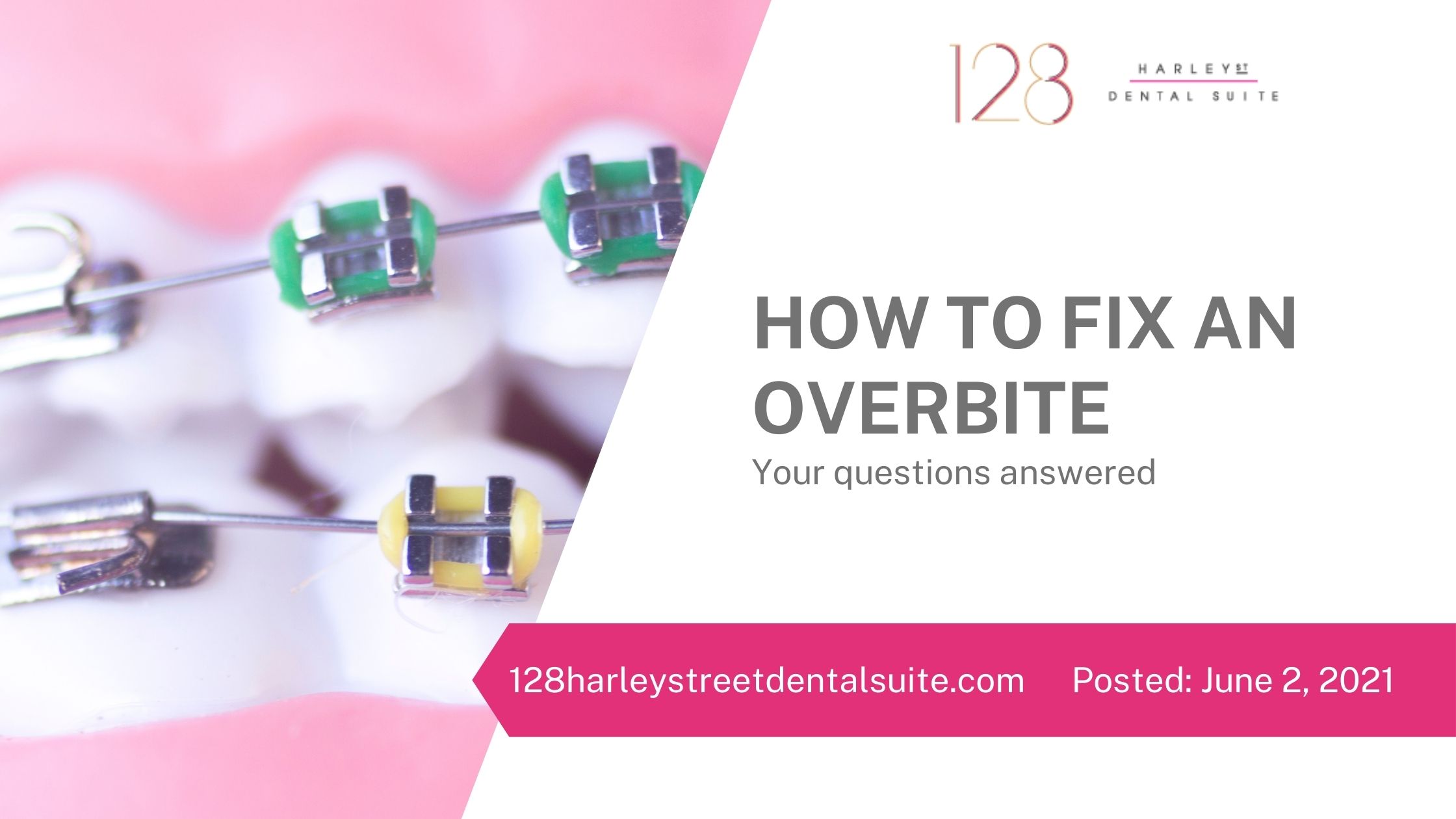
The size, shape, and alignment of our teeth take centre stage when it comes to the quality of our smile and facial aesthetics. While some people are born with perfectly aligned teeth and a naturally beautiful smile, others may have certain tooth alignment flaws that affect their appearance and personality.
One of the most common orthodontic problems that affect one’s oral health and ruin the smile and appearance is an overbite. This article explains everything you know everything to need to know about an overbite and how it is treated.
What Is An Overbite?
According to the American Association of Orthodontists, an overbite – also known as a deep bite – is a condition in which the upper front teeth overlap the lower ones excessively when all the teeth come together. There are two main types of overbites; dental and skeletal overbite. A dental overbite occurs when the upper front teeth are positioned excessively forward compared to their lower counterparts. On the other hand, the upper jaw protrudes excessively forward in comparison to the lower jaw.
How To Tell If You Have A Skeletal Overbite?
It may not be possible to detect whether one has an overbite or to ascertain its type just by the naked eye. Your orthodontist will perform a detailed clinical examination, including evaluating the x-ray images of your teeth to visualise the relative position of your jaws to confirm the type of overbite. Orthodontists use a special type of x-rays, the cephalograms, which provides detailed information regarding the relative position and angulation of teeth in relation to the jaws and other important facial landmarks. The cephalograms also help orthodontists in preparing a detailed treatment plan for treating the underlying problem.
Skeletal Overbite Versus Dental Overbite, What’s The Difference?
As discussed earlier, a dental overbite occurs when the upper teeth protrude excessively compared with the lower ones. This type of overbite occurs primarily because of the improper angulation of the teeth, mainly caused due to parafunctional dental habits like thumb sucking, tongue thrusting and nail-biting. The treatment of dental overbite is performed with traditional braces or Invisalign aligner – to close the excessive horizontal gap between the upper and the lower front teeth.
On the other hand, a skeletal overbite occurs due to the malformation or misalignment of the jaws. It can also occur when there is a mismatch between the size of the jaws. Treatment of skeletal overbites usually involves surgical treatment to reposition or realign the jaws.
How Long Will It Take To Fix A 4 mm Overbite?
The time required for fixing a 4mm overbite depends on various factors, including the type of orthodontic treatment, the skill and expertise of the orthodontist, and patient compliance. Your dentist may either recommend traditional metal braces or Invisalign aligners for treating overbite. Generally, it may take you anywhere between one to two years to get a 4mm overbite fixed. In some cases, your dentist may also consider using additional appliances, like elastics, to accelerate the tooth movement. Your orthodontist can give you a rough estimate required for your treatment based on your oral health status and orthodontic needs.
Are Braces The Only Option For Treatment?
Metal braces are one of the most effective and time-tested options for fixing orthodontic problems, including correcting an overbite. However, they are not the only option for overbite correction. If you do not wish to get traditional braces for your treatment, you may also consider getting Invisalign aligners, which have the added advantage of being more convenient, comfortable, and virtually invisible when worn.
Can An Overbite Cause Jaw Problems?
Any condition in which the teeth or the jaws are not optimally aligned can lead to various dental complications, in addition to causing aesthetic concerns. An overbite may result in the following problems:
- Excessive tooth wear
- Tooth sensitivity
- Difficulty in eating
- Speech problems
- Gum disease
Perhaps, the most significant complication of a deep bite is the risk of developing temporomandibular joint or jaw disorders. An improper bite puts excessive pressure on the jaws, leading to problems such as difficulty in opening the mouth, clicking or popping sounds while eating or speaking, jaw pain, and jaw joint dislocation. Therefore, you must seek treatment for overbite as soon as possible to avoid damage to your oral health and physical wellbeing.
Will Fixing An Overbite Change My Face Shape?
Any problem involving the bite or jaw misalignment can affect your smile and personality. An overbite can have a significant effect on your appearance and facial aesthetics. Getting an overbite fixed with braces or Invisalign aligners can help you get rid of these aesthetic problems, and enjoy a healthy, lasting and beautiful smile.
What Braces Fix An Overbite?
Traditional metal braces are one of the most effective options for fixing a dental overbite. The orthodontic braces, or the brackets, contain a slot through which an orthodontic wire passes. The tension in the orthodontic wire exerts pressure on the teeth, resulting in their movement or realignment. In this way, braces gradually fix excessive upper teeth overlap compared with the lower ones. Another option for fixing an overbite is the Invisalign aligners. This system uses a series of aligners that apply gentle pressure on the teeth and move them in the desired position. Dentists may also use removable appliances to fix mild cases of an overbite problem.
When it comes to fixing orthodontic problems, it is imperative that you go to an experienced and qualified Specialist orthodontist . If you are looking for a reliable and renowned orthodontic practice in Harley Street, then look no more. 128 Harley Street Dental Suite is at your service! We take pride in offering the highest-quality dental services to our esteemed patients in a comfortable and relaxing environment. So, book an appointment for a free e-consultation today and let us give you a beautiful, attractive and healthy smile.
The right way of wearing a FaceMask
The right way of wearing a FaceMask
During global pandemics, wearing a mask is one of the most important actions one can take not only to protect yourself but also to protect others.
There are several types and categories of masks to be used, which usually differ by the level of filtration efficiency.
Surgical masks are the most common ones. Below is a diagram of the most common types of masks.
The first picture shows the surgical mask from the front and the second picture shows the masks from behind. It is important that the user wears the mask with the front of the mask facing forwards.
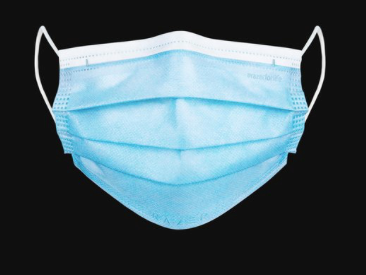
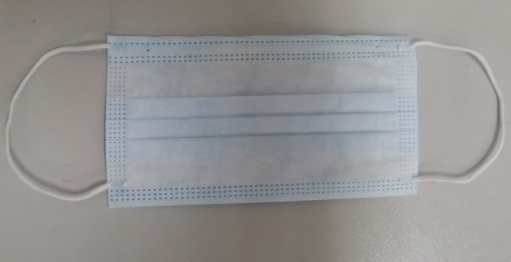
Surgical masks shown above are once again the most common ones, and being water proof can protect you from droplets and splashes. The effective protection of these masks lasts around 4 hours to 8 hours maximum so it is important that they are changed and if soiled immediate change is advised.
Other type of masks include N95 masks which means that they can filter 95% of the air particles. With these type of masks, the user is protected from vapours and aerosols. These masks like the common surgical masks should also be used for a maximum time period of 4 to 8 hours.
N99 masks or FFP3s, as the name suggests filters 99% of the particles.
Homemade masks could be considered a make-shift type of mask however the surgical masks and the other types of masks are superior. The reason being is that hand made masks are usually not water proof and the fabric is permeable to viruses and other microscopic organisms.
The use of masks is now recommended, and even compulsory in certain instances, in public places, including public transport and other public places.
It is vital to wear a mask:
- If you have a cough or are regularly sneezing.
- If you are or have been in contact with someone who has been tested positive and has been contacted by track and trace.
- If you are a medical worker, you must wear a mask whenever you are in contact with patients.
- If you have been in a place where social distancing is not always possible (store, work, school, etc.).
Step by step Guide on how to put on a Facemask
- First, determine in which side you should place it over your face; the blue side (coloured side as some masks can have different colours such as green or white) should be facing the outside that is not towards your face but towards the public you might be encountering on your daily commute.
- The bendable bit should be on the top and the less bendable bit should be facing downwards. This allows the bendable part of the mask to be moulded by your fingers after ensuring that they are clean and create a more air-tight fit.
- Once again, ensure to have the bendable edge on the top and the right side of the mask facing to your face. Most of the time, the coloured side should be facing away.
- Put the bendable edge on your nose and place the loops over yours ears. Some masks have ties, then hold your mask while placing the ties behind your head.
- Pull the bottom of your mask over your mouth. Make sure it covers it all, as well as your chin.
- Ensure that there is a seal at the bottom where it contacts just below the chin area.
- Once the mask is in position try not to touch or alter its position.
- It is important that you ensure that the mask is at all times covering your nose and mouth. If you do touch the mask, wash your hands before and after with soap and water. If soap and water are not available, use hand gel.
Change your mask every 4 to 8 hours unless it has been damaged, soiled, or made wet in which case the mask should be replaced immediately.
Kindly contact us on 02079358777 if you have any queries about how to wear a mask. At 128 Harley Street Dental Suite, we take pride at ensuring your safety at all times.
How Long Does It Take To Put Braces On Teeth?
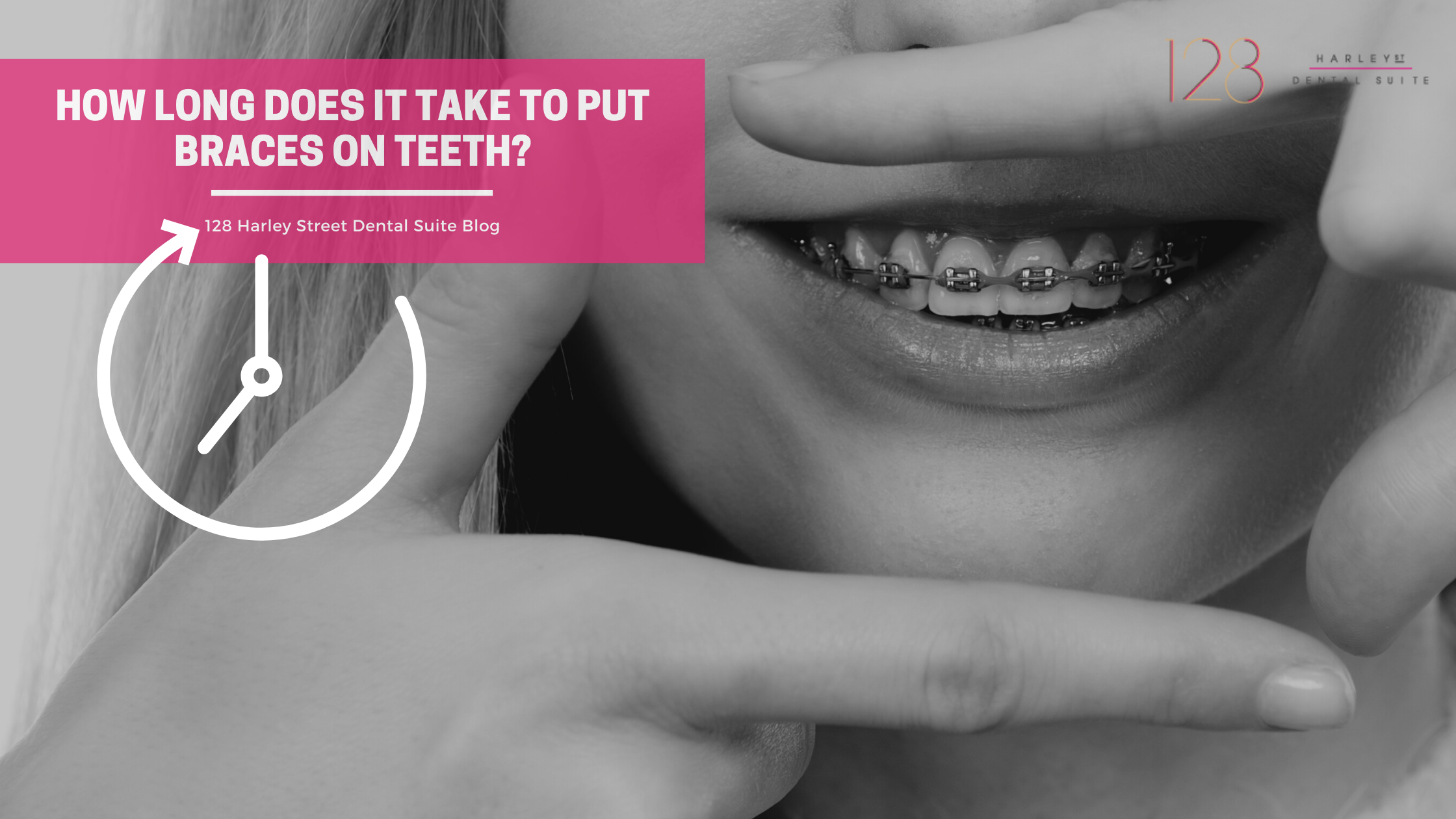
Getting braces is a big step for individuals who are seeking a healthy and beautiful smile. Not only do braces give you an aesthetically pleasing smile, but they also fix underlying health issues like an overbite or underbite, tooth crowding and spacing.
While getting teeth braces is a simple and straightforward process, many people are unfamiliar with the process. If you are curious about how long it takes for your orthodontist to put braces on your teeth, then read on to learn more – and put your mind at ease.
How To Put Braces On Teeth Step-by-step
Broadly, there are two types of braces; the fixed and the removable braces. The conventional fixed braces, cannot be put on your teeth at home. After your orthodontist cleans and drys your teeth, they will attach each bracket to your teeth using a special adhesives. On the other hand, if you are undergoing orthodontic treatment with removable aligners, then you will try in the orthodontic appliance at the practice and then have to learn how to put it in and take it out yourself at home, this is a simple process.
Wearing your removable aligners for the first time is not a complicated process. Your aligner manufacture will already design them in way that they should snugly fit over your teeth.
- Simply take one of your aligners – upper or lower – and gently place it over your teeth.
- Next, use your thumbs to apply gentle downward pressure so that the aligners fit over your teeth.
- You will hear a click sound once your aligners are in position.
- That’s it! You can follow the same procedure for wearing the other aligner.
How Long After Getting Braces Can You Eat Solid Food?
It is not uncommon to have pain and discomfort during initial few days after getting your teeth braces. However, as your mouth adjusts to these appliances, the pain should go away. Initially, you may find it hard to chew solid food because your teeth hurt and the brackets themselves might rub your cheeks causing irritation and pain. Therefore, orthodontists recommend eating soft foods for the first few days, such as mashed potatoes, yoghurt, soup and soft fruits. You can switch to semi-solid or solid foods once your teeth have become accustomed to the braces.
In the meantime, you can relieve the pain by using over the counter pain relievers. If the sharp edges of the brackets are injuring your cheeks or lips, you may try placing orthodontic wax over them. You can also minimise the inflammation around the teeth and oral soft tissues by rinsing your mouth with salt water.
Foods To Avoid With Braces
The American Dental Association recommends avoiding hard and sticky foods while wearing braces. This is because sticky foods like popcorn, chewing gum and caramel, or hard foods like apples, corn on the cob, or steaks may result in the dislodgment of your braces. Therefore, it is always a good idea to eat soft or semi-solid foods while you are wearing braces.
What To Eat With Braces In The First Week?
During your first week of getting braces, you might experience some pain and discomfort during eating. This is because your teeth have become sensitive due to the pressure braces put on them. Therefore, you should eat soft foods such as yogurt, cereals, soft fruits and cooked vegetables during the early few days of your treatment with braces.
Can You Eat Popcorn When You Have Braces?
Every one loves to eat popcorn every now and then. Unfortunately, orthodontists advise against eating this snack when you are wearing braces. Why? Because popcorns can get stuck between your teeth, brackets and the orthodontic wire, and it’s very hard to completely remove them through brushing or flossing. Over time, harmful bacteria will utilise the food debris on your teeth and release toxins that cause teeth cavities and gum inflammation. Therefore, it is best to avoid popcorns, or any other sticky snacks while you are wearing braces.
How Long Does It Take To Get Braces Tightened?
The “tightness” of your braces is due to the tension in the wire that is attached to them. At every appointment, your orthodontist will remove the elastic wires that attach the wire to the brackets and replace them with fresh ones. Your orthodontist may also change the orthodontic wire to increase or decrease the tension. The orthodontic wire your orthodontist will use also depends on the type of braces you are wearing, the traditional metal braces or the ceramic braces. This tension in the orthodontic wire is transferred to the tooth roots, realigning the teeth, moving them in the desired direction. This entire process does not take very long – and it is normally completed in under one hour.
How Long Does The Appointment Take To Get Braces Off At the Last Appointment?
Once your orthodontic treatment has been completed, your orthodontist will remove the braces from your teeth – one by one – using a special instrument. Once your orthodontist has removed all the brackets, they will then professionally clean your teeth to remove plaque and tartar deposits which may cause gum inflammation. Finally, your orthodontist will polish your teeth to improve their aesthetics, and to minimise chances of attachment of plaque and tartar deposits in the future. Therefore, your appointment for taking off your braces may take anywhere between one to two hours.
How Long Does It Take To Fit Fixed Braces?
Fitting braces on your teeth is a simple process. Your dentist will attach each bracket to your teeth with an adhesive. The entire process can be completed in a short amount of time – typically, under an hour.
Getting braces is a painless and simple procedure, and there is no need for an anaesthetic. If you are also thinking about getting braces, then 128 Harley Dental Suite should be your first choice. Being a specialist orthodontist centre in Harley Street, we offer the highest quality orthodontic services to our patient. No matter what your orthodontic problem is, we can fix it for you. So, what are you waiting for? Book a free e-consulation appointment with us today and let us give you the smile of your dreams.
Orthodontic Wax, Everything you Need to Know
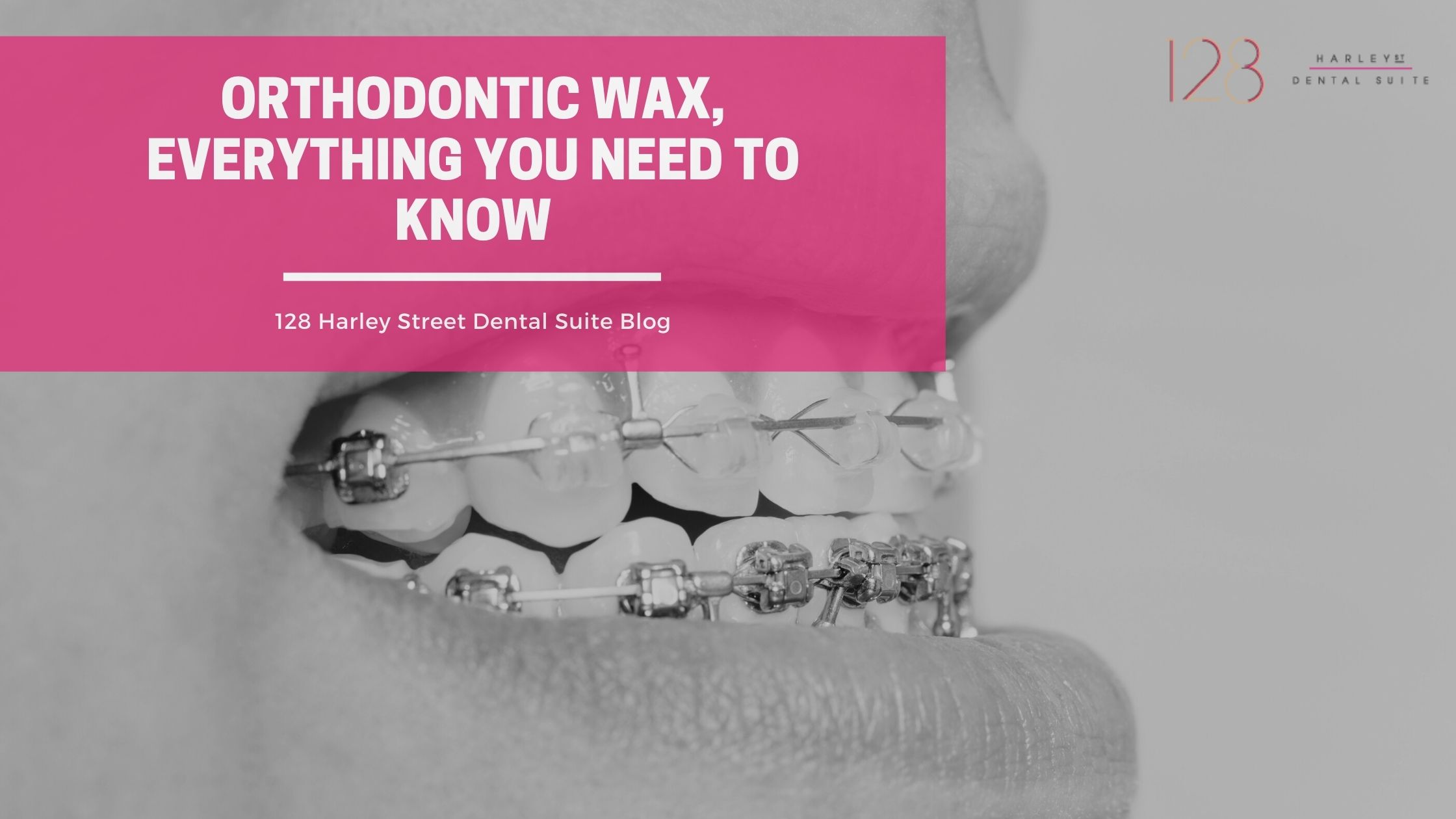
Imagine you are relaxing on a Saturday night, and all of a sudden you feel something sharp impinging on your cheeks. You rush to the mirror, open your mouth, and see that your orthodontic wire has broken and its sharp edge is touching your cheeks – hence the irritation. What to do in this case? Naturally, it would be hard to visit your orthodontist now. So, what to do now? Don’t worry, the orthodontic wax comes to your relief.
The orthodontic wax, is a soft, harmless protective material which is used for protecting teeth and gums for individuals who are wearing braces For orthodontic patients, orthodontic wax is nothing short of a blessing, as it comes in handy in preventing injury to the gums, cheeks and the lips – if there is a broken orthodontic wire or a lose bracket which impinges on the oral tissues.
Continue reading to find out more about orthodontic wax, why it is used, and how to use it.
What is Orthodontic Wax Made of?
The orthodontic wax is mostly composed of natural waxes. However, their constituents may vary according to different brands. Some dental waxes contains carnauba wax and beeswax, while others may contain paraffin wax. Also, wax manufacturers add various modifiers to give a pleasant taste and smell to increase their acceptability. Orthodontic waxes also come in different colours.
When is an Orthodontic Wax Needed?
You may require an orthodontic wax in the following cases:
- The NHS recommends using orthodontic wax for protection when a broken orthodontic wire, retainer which impinges on the cheeks or gums
- A sharp edge of a chipped or fractured tooth
- The American Dental Association (ADA) recommends using orthodontic wax to prevent impingement againts the sharp edge of a removable denture.
- A removable aligner which is causing discomfort or irritation over the gums
Is Orthodontic Wax Safe to Swallow?
The orthodontic wax is absolutely harmless and safe for use in the oral cavity. In fact, the Canadian Association of Orthodontists suggests that it is absolutely normal it someone accidentally eats, or swallows a little wax in case it falls off from the bracket or tooth during eating or speech.
How Does Orthodontic Wax Work?
The orthodontic waxes are specifically designed to be solids at room temperature. However, when you hold the wax, the warmth of your hands and fingers will melt it so that you can easily mold it around an orthodontic wire, bracket, or a sharp edge of a chipped tooth to prevent accidental injury. The orthodontic wax also contains small quantities of sticky natural waxes which allows it to adhere to the tooth or bracket for some time – while you book an appointment with your orthodontist to get the problem fixed.
How do you Use Orthodontic Wax?
Whether you are using orthodontic wax for protecting your gums from new braces or aligners, or you have a sharp edge from a broken tooth, the procedure to use the wax is the same. Here’s how The American Association of Orthodontics (AAO) recommends using the orthodontic wax:
- Wash your Hands – applying the wax on your teeth with dirty hands will affects its adherence to the bracket or wire, causing it to fall off very quickly.
- Brush your Teeth – thoroughly clean the tooth surface which you want to protect. The cleaner the tooth, the better will be the attachment of the wax to it.
- Melting and Shaping – next, hold a piece of wax in your fingers. You will feel that as soon as you hold it, it starts to soften. Now, role it into the shape of a ball and flatten it slightly.
- Apply Orthodontic Wax – finally, apply the wax gently on the problem area and make sure it sticks. Don’t apply too much pressure as it may result in excessive thinning of the wax, and defeat the purpose. If the wax keeps falling, remove the wax and replace it with fresh wax.
Can you Use Orthodontic Wax with Invisalign?
Orthodontic waxes can be used with any orthodontic appliance. Some people feel irritation or discomfort around the gums when they wear the Invisalign removable aligners for the first time. However, as they get used to their new appliance, the irritation goes away. While you are getting accustomed to your new aligners, there is no harm in using an orthodontic wax to reduce the discomfort.
Can you Sleep with Orthodontic Wax?
The orthodontic wax does not contain any harmful or toxic ingredients. Therefore, you can place it in your mouth while sleeping. However, please note that the orthodontic wax is just a temporary solution. If you have a chipped tooth or a damaged denture which is creating discomfort, it must be treated immediately by your orthodontist. You can use the orthodontic wax while you wait for your dentist’s appointment.
For those who have been wearing braces or removable aligners, they would already be familiar with the dental wax. However, if you are thinking about getting braces, then getting familiar with the orthodontic wax will help you in making your orthodontic treatment a comfortable experience – as orthodontic wax will become a part of your orthodontic treatment journey.
If you are looking for an orthodontic clinic which not only gives you a charming, beautiful smile, but also restores optimal functionality of your teeth and gums, then 128 Harley Street Dental Suite should be your first choice. Our qualified and highly experienced dental team will ensure than you get the best and highest quality treatment in town. Not only this, if you visit our website here, you will become entitled to a free virtual consultation and cost estimation by our orthodontists.
So, book an appointment today and take your first step towards a beautiful and lasting smile and perfect oral health.
How to fix an underbite
How to fix an underbite
What is an Underbite?
An underbite, first of all, also known professionally as a Class III type of bite, is when the lower teeth extend beyond the upper and ideally the reverse is true, where the top teeth meet the lower teeth by overlapping them. In this type of bite, the lower jaw protrudes beyond the top jaw, making it impossible for the lower row of teeth to align behind the upper row of teeth as they should.
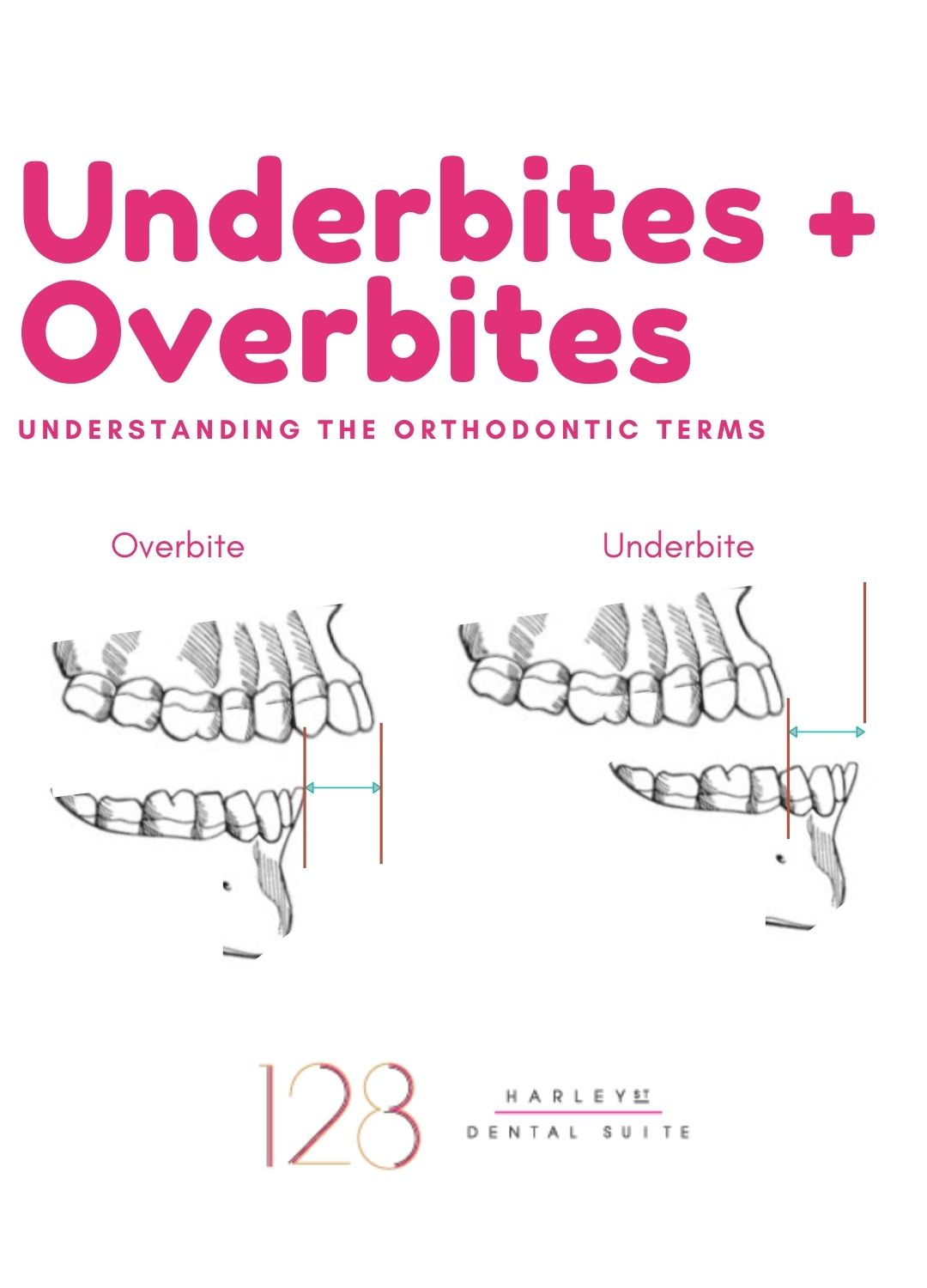
What causes underbites and overbites?
They can be caused by the upper jaw bone being underdeveloped or the bone in the lower jaw being overdeveloped or a combination of both. It can also be due to the position of the teeth, due to a postural habit when closing or due to habits.
Underbites can also result from behaviours like thumb-sucking or caused by genetics or as the result of an accident. Whatever the cause, severe underbites should be treated immediately or as early as possible however there are occasions where delaying treatment is beneficial for you.
Underbites can affect 5-10% of the population and should not be confused with underbites.
Underbites vs Overbites – What are the Differences?
It is once again normal for your top teeth to overlap the bottom teeth and just because your upper teeth extend somewhat over your lower teeth, it doesn’t necessarily mean that you have an overbite. It is also normal for the top teeth to protrude over the lower by a certain degree. It is when this overlap is excessive that you might say that you have an underbite.
Minor overbites are very common and usually no treatment is needed.
What causes an overbite?
The overlap should measure up to 4 millimeters. In excess of this, causes such as:
- genetics
- a small lower jaw
- a small chin
- misaligned bites
- thumb sucking
- poorly fitted crowns
- gum disease
- injury
Also, sometimes its just the position of the teeth.
Overbites are technically referred to as Class II bites, there are a range of of devices that help in correcting this type of bite.
Underbite Treatments
A team of specialist dental surgeons, also known as orthodontists will determine the best course of action to treat your misaligned bite.
Your options could include:
Some treatment options for children with underbites include:
- Removable type of braces such as an upper jaw expander, a device that is placed in the upper jaw which can be widened nightly until treatment is complete.
- A reverse-pull face mask, which wraps around the head and attaches to the braces attached on the back upper teeth to pull the upper jaw forward.
- A chin cap, which restricts the growth of the lower jaw.
- Fixed braces to adjust the position of the misaligned teeth.
- Aligners to render a more discreet type of solution
Will I needed teeth extracted for an underbite?
Depending on your type of underbite or the bite you present with, lengthier treatments, with braces can be accomplished with Dental extractions, to relieve the pressure of overcrowding and help the jaw relax into a more natural position.
Surgery to act as an adjunct to fixed braces to modify the position of the top and bottom jaws.
Please contact us on 02079358777 or via email to organise a consultation to discuss your needs. At 128 Harley Street Dental Suite we aim to tailor the treatment to your needs.
Invisalign vs Braces Results: An Invisalign Guide for London
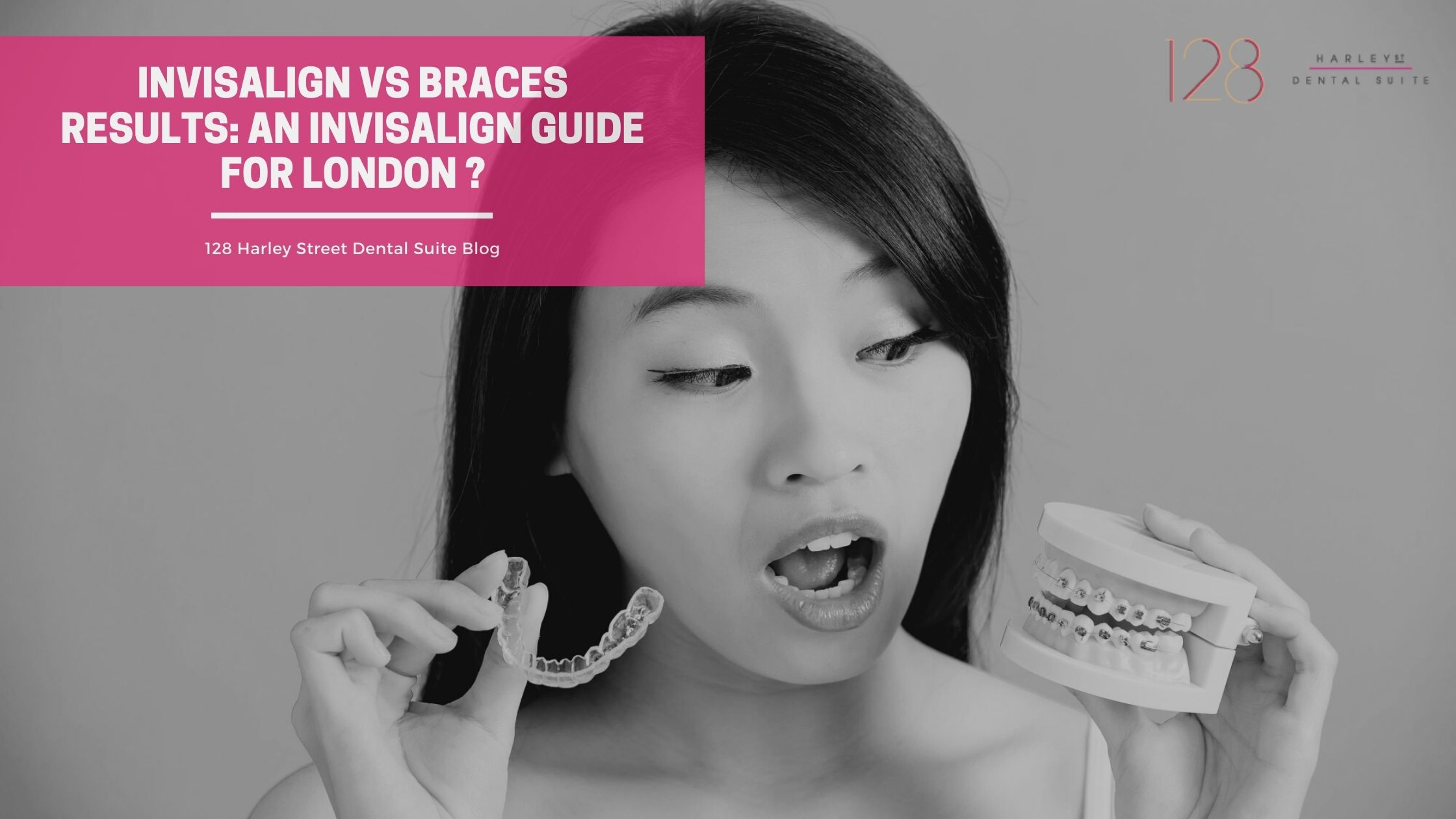 The number of UK adults seeking orthodontic treatment is on the rise, according to the British Orthodontic Society.
The number of UK adults seeking orthodontic treatment is on the rise, according to the British Orthodontic Society.
In 2016, 75 percent of dental experts said they were seeing more patients seeking private orthodontic treatment. By 2018, that figure had increased to 80 percent.
So, if you’re looking to straighten your teeth and perfect your smile, you’re not alone. And, as you research your options, you won’t be the only one asking the differences between braces and Invisalign.
These two different options will improve your smile. But what are Invisalign vs braces results, in terms of the speed and efficiency with which they straighten your teeth? Here’s what you need to know.
Invisalign vs Braces, Which is Faster?
Every patient’s needs will be different, of course. In general, though, Invisalign tends to give you results faster than traditional braces.
The average metal braces application requires between 18 and 24 months to straighten teeth. Meanwhile, with Invisalign, the average patient finishes their treatment in 12 months. Some treatments take as little as six months, though.
In the end, it depends on what you hope to fix with your orthodontic treatment. A simple straightening could take six months with Invisalign. Meanwhile, serious overcrowding or other, more intensive issues could take 18 months with Invisalign and even more with regular braces.
Differences Between Braces and Invisalign
You might be wondering, if Invisalign’s faster, why would I choose regular braces. But the Invisalign vs braces debate has more to do with just the treatments’ timeframes.
As you already know, your Invisalign treatment relies on clear aligners to move your teeth into position. Your dentist or orthodontist will have you in for a scan of your teeth, which they will use to chart the path of your Invisalign treatment. You’ll get aligners that will slowly shift your teeth into the places where they belong, and you’ll visit a dental professional every few weeks to make sure everything’s progressing properly.
Braces, on the other hand, require visible hardware to shift your smile. You’ll go in to see your dentist every four to eight weeks to tighten your braces and make sure you’re maintaining them properly.
That’s the first and most major difference between the two treatments. Learning the pros and cons of each treatment will tell you a bit more about each one, as well.
Invisalign vs Braces Pros and Cons
Most people who opt for clear Invisalign aligners do so because the treatment is more cosmetically appealing. Indeed, Invisalign is nearly undetectable to others.
That’s just one advantage of Invisalign in comparison to braces. As previously mentioned, they take less time to work than braces. Plus, they’re convenient — you can pop your Invisalign in and out to eat, drink and clean them.
Oppositely, you have to wear your braces around the clock, and they can be tough to clean. You will also have to watch what you eat when you have braces — certain sticky or crunchy foods can damage your orthodontics. With Invisalign, though, you won’t have any dietary restrictions.
But Invisalign isn’t a perfect treatment, nor is it a universal one — fixed braces have their benefits, too. For starters, they can fix more complex issues that Invisalign can’t fix.
Invisalign can handle the following issues:
- Overbite
- Underbite
- Crossbite
- Gap teeth
- Open bite
- Crowded teeth
- Crooked teeth
Beyond that, though, you won’t be able to use Invisalign. So, a major pro of traditional braces is that they can treat bigger problems than Invisalign can.
You’ll have to check in with your dentist regularly, whether you choose Invisalign or braces. And many people report feeling a bit of discomfort when they get their braces adjusted or change Invisalign aligners. Those disadvantages apply to both treatments, though.
There’s also the issue of Invisalign vs braces cost — one tends to be much cheaper than the other.
Is Invisalign More Expensive Than Braces?
In short, yes: Invisalign is more expensive than braces.
Again, it depends on how intensive your braces treatment is — it could cost many thousands of dollars. In most cases, though, Invisalign carries a higher price tag than what braces cost. The aesthetics and quickness of treatment makes it a more attractive — and, therefore, expensive — option.
You should consult with your dentist, though, as prices vary from case to case and from practitioner to practitioner.
Invisalign Scan vs Impression
Let’s say you decide to go for Invisalign over braces. To get the process started, you’ll visit your dentist for an Invisalign scan. Yes, Invisalign relies on a high-tech scan, rather than taking impressions of your teeth.
There’s a reason why, in the Invisalign scan vs impression debate, the former always wins. For one thing, it takes minutes to take a scan of a patient’s teeth. The resulting images are much less messy to create than impressions, too.
With a mould of your teeth, it’s more likely that the aligners would come back with an imperfect fit. A digitized scan ensures that the aligners hug your teeth and work as described.
The Invisalign scanner can also show you what your teeth will look like after your treatment finishes. You can probably picture a straight smile in your head, but it’s even more inspiring to see what it will look like on you!
Invisalign vs Braces Results: Which One is For You?
In the end, Invisalign vs braces results are only one factor to consider when straightening your teeth. You need to choose the right orthodontic method for you, your lifestyle and your goals.
Your best bet is to speak to a dentist or orthodontist who can help you select the right treatment. We’re here to help with your braces or Invisalign London treatment. Click here to sign up for your e-Consultation and get started today.
Do Invisible Braces Work for Crowded Teeth?
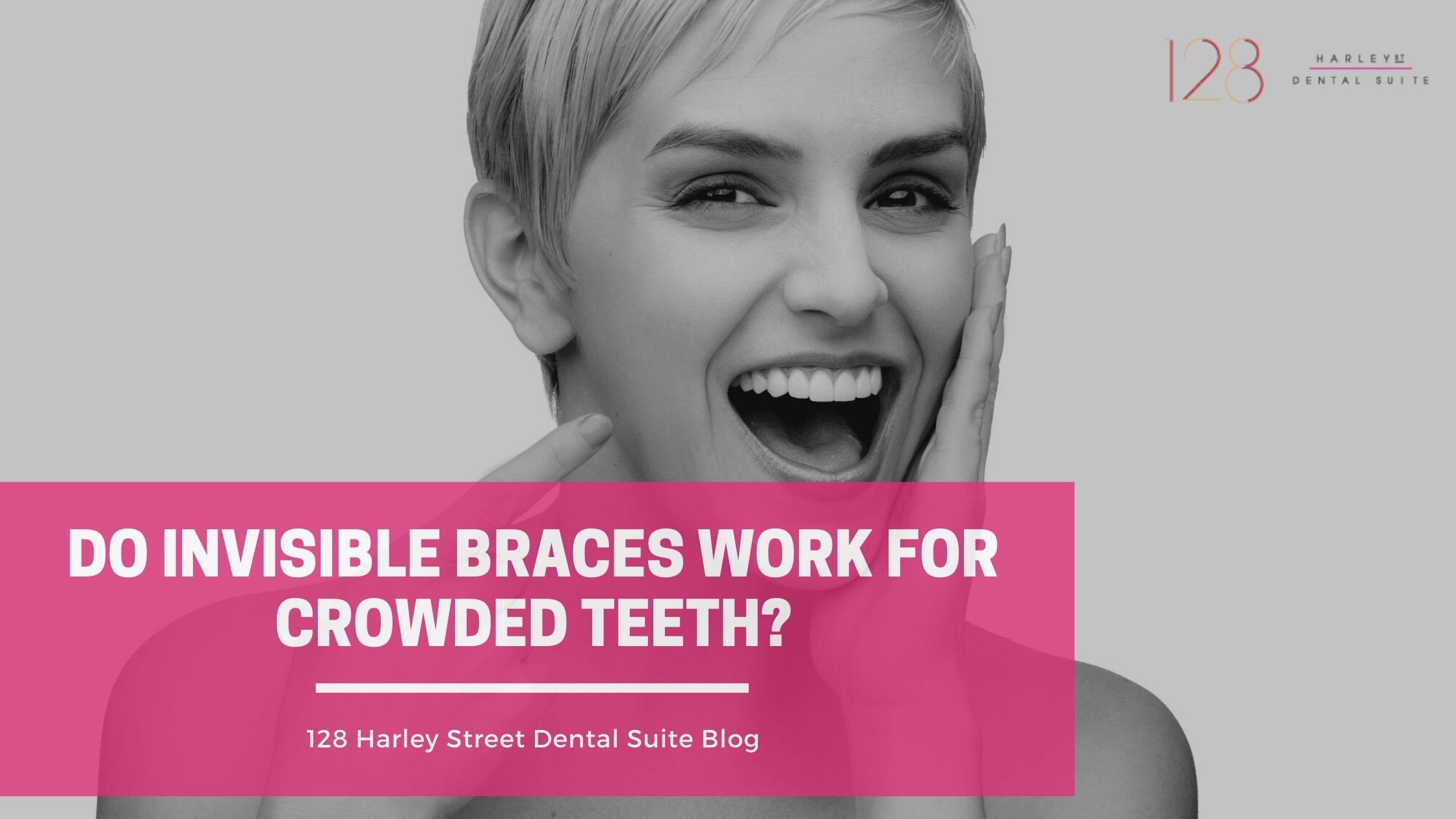
Did you know that one in five Brits reports feeling self-conscious about their teeth? If you fit into this category, even simple daily gestures like smiling can leave you feeling uncomfortable.
That’s why 61 per cent of people admit to covering their mouths when they laugh. Others avoid smiling and laughing altogether, which can lead to misconceptions about being anti-social, even among the most gregarious people.
Of course, the thought of wearing braces for a few years proves a daunting solution and one that most adults don’t relish. That’s why so many patients turn to Invisalign in the hopes of avoiding traditional braces.
When it comes to how invisible braces work, there’s a learning curve. From removal with attachments to keeping your aligners clean, here are our answers to your top questions.
How to Remove Invisalign With Attachments
Invisalign is a convenient and less noticeable method for correcting orthodontic issues than metal braces. But, like anything else in life, it isn’t easy in the beginning. You’ll have to get used to a variety of different daily realities.
These realities include needing to remove your aligners before every meal and learning how to live with attachments. We wanted to start this article by talking about attachments because so many people have never heard of them.
For patients requiring a more thorough intervention than clear aligners alone, there are attachments. Attachments help remedy issues like stubborn teeth, extreme gaps, or crowding that requires a heftier tooth correction.
What are attachments? Attachments are extensions that get added to your teeth.
Manufactured from a tooth-coloured material known as composite resin, they tend to blend right into your mouth. (Dentists use composite resin to craft cosmetic bondings and fillers.)
Your orthodontist will adhere these attachments to your aligners, providing extra leverage to adjust tooth positioning. Orthodontists typically use them to handle intrusions, extrusion, or rotations. Attachments include buttons and bumps.
Once patients get attachments, they may experience more trouble removing their aligners at first. That’s because the aligners will feel tighter, especially when initially installed.
As with the removal of aligners without attachments, you’ll want to work from the back forward. Lift off the easiest to remove parts of the aligner first and then use your fingernails to get under the edge of the aligner to lift it over the attachments.
How to Remove Invisalign Without Cracking
How do you avoid cracking when removing Invisalign liners? Start with a warm, dry mouth. That way, your fingers will get a better grip, and the plastic will also feel more malleable.
If you’re still having trouble, use a paper towel or a pair of plastic gloves for better grip. Always start from the back molars working towards the front of your teeth.
Some patients also swear by using an aligner hook. You can easily purchase aligner hooks from places such as Amazon, and they provide you with effective assistance when getting aligners out of your mouth.
The techniques above will ensure you properly remove your aligners without any cracking.
Does Invisalign Work for Crowded Teeth?
You’ll need to work with an experienced Invisalign dentist and go through a screening to determine if invisible braces are an option for your current needs. That said, invisible braces can remedy a variety of tooth crowding issues.
As the name suggests, invisible braces are largely undetectable while you’re wearing them. Yet, they prove useful in straightening the teeth of those with crowded alignments.
This treatment is also ideal for those who desire a subtle and less conspicuous treatment option. Invisalign remains an excellent intervention for dental issues such as crossbite, overbite, crowded teeth, and gapped teeth.
Unlike metal braces, invisible braces are removable and virtually unnoticeable while in place. Removing your aligners allows you to brush and floss carefully. You also take them out to eat.
When worn a minimum of 22 hours per day, you’ll enjoy the full benefits of treatment. In other words, you only remove the liners for eating and cleanings.
What’s the caveat to all of this? For severely misaligned teeth, you may need to explore additional dental treatment.
Invisalign vs Braces: Which Is Faster?
How many years will you need to wear invisible braces? There’s no simple answer to this question. After all, the severity of your overcrowding has a direct impact on the timeline of the correction process.
The process begins with the creation of dental impressions. Once these are completed and sent away, you’ll wait approximately four weeks to get your first set of aligners or trays.
Each set of aligners get worn for a fortnight before moving on to a new pair. Patients with the mildest misalignment may complete their full course of treatment in a matter of a few months.
For others, they may need to wear aligners for one year to a year and a half. If you know much about metal braces, you’ll realise that the timeline for invisible braces often proves drastically reduced.
What makes invisible aligners so effective? They’re crafted based on the dimensions of your precise 3D tooth impressions.
What does this mean for you? They fit perfectly. You’ll also be pleased to learn they’re among the most comfortable treatment options when it comes to overcrowded teeth.
Differences Between Braces and Invisalign
What are some of the significant differences between metal braces and invisible braces? Nobody enjoys the look of metal braces. Especially as an adult.
They also prove uncomfortable and can lead to friction sores on the insides of your lips and the interiors of your cheeks.
But with invisible aligners, these issues vanish. You’ll enjoy an attractive smile throughout the entire duration of your treatment. That means no more feeling self-conscious, and no more self-deprecating comments or need to explain why you have braces.
Metal braces can also interfere with proper dental cleaning. The metal brackets are notorious for catching and holding food particles and plaque. In turn, this can lead to gingivitis, cavities, and bad breath.
But with Invisalign braces, you take them out every time you eat, allowing for easy access to brushing and flossing. Your teeth remain cleaner and cavity-free. Your breath will stay pleasant, and you’ll never have to worry about food particles stuck between metal brackets.
Unlike metal braces, aligners can be removed anytime. Although you must be sure to keep them in 22 hours of the day, this flexibility means they fit perfectly into your everyday lifestyle. What’s more, you’ll never have to deal with metal wires, brackets, or elastics.
How to Clean Invisalign
Every time you remove your aligners, you’ll want to brush your teeth as well as the trays. But you’ll also need to set aside some time each day for a quick aligner soaking.
Soaking your aligners remains the best way to ensure your aligners stay hygienic. The water you soak them in should contain Invisalign cleaning crystals or a denture cleaner. That way, they’ll always stay fresh and clean.
What are some things to avoid when it comes to caring for your trays? For starters, avoid soaking your trays in hot water or mouthwash.
Why? Because these liquids can damage your trays. After you’ve completed the soaking process, brush over the trays with your toothbrush to remove any stubborn particles, and you’re all done.
How Does Invisalign Work?
Now that you’ve got a better understanding of what invisible braces can do, let’s take a closer look at how this remarkable technology works. These braces treat overcrowded teeth by coaxing them gradually into the right alignment.
Each set of invisible aligners gets designed to move teeth by one-quarter of a millimetre to achieve realignment. As your teeth move, the space in your mouth increases.
Tooth overcrowding diminishes. Eventually, your teeth finish in their desired positions. As already mentioned, you may need the addition of attachments to get your desired look.
Don’t be afraid of getting attachments. Once you get used to removing your aligners with these new attachments, the process will become as simple as changing shirts or removing your contacts. Consider buying an aligner hook to make removal a cinch.
Invisible Braces Work
Are you tired of feeling self-conscious about your smile? Would you like to improve your dental health while finally getting the flashy smile you’ve always longed for? Then, it’s time to learn whether invisible braces are right for you.
Find out more about London’s leading orthodontic centre. Contact us today to schedule your first consultation and discover firsthand how invisible braces work.
